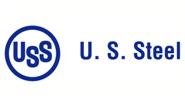Steel Mills

U.S. Steel Operations Made Money in 4Q
Written by Sandy Williams
January 28, 2014
US Steel reported a net loss of $122 million for the fourth quarter of 2013, compared to a Q3 net loss of $1,791 million and $50 million net loss in Q4 2012. The fourth quarter loss was due mostly to $302 million of charges related to the shutdown of the Hamilton steel making facility. Adjusted net income for fourth quarter after excluding restructuring charges and a favorable tax related item was $38 million.
Net sales for Q4 totaled $4.3 billion, up from 4.13 billion in Q3. Steel shipments fell 6 percent year-over-year to 4.9 million tons. Average realized price for flat roll was $750/ton, down from $752/ton in Q3 and up from $721/ton in Q4 2012. US Steel capacity utilization at domestic flat rolled facilities was 73 percent in fourth quarter.
Restructuring charges and a 2.1 billion non cash goodwill impairment charge resulted in a net loss for 2013 of $2.064 billion compared to $124 million in 2012.
Flat rolled shipments increased in Q4. Lower raw material costs were offset by a $45 million expenditure for repairs and maintenance, including relining a blast furnace at Gary Works and planned blast furnace maintenance at Fairfield works.
The company reported their average capacity utilization for North American steel operations was 80 percent.
Higher shipments returned the European segment to profitability. Tubular sales decreased due to lower shipments, increased imports and lower drilling activity.
“We are on a multi-year journey to earn the right to grow by improving our balance sheet and achieving sustainable profitability,” said US Steel CEO Mario Longhi. “Our fourth quarter results reflect our early efforts on this journey as all segments were profitable and in total, we had an overall improvement in operating results compared to the third quarter.”
US Steel expects stronger results in Q1 2014 from higher flat roll shipments and pricing along with less maintenance costs. The Europe segment is expected to be comparable to fourth quarter as higher pricing is offset by increase in raw material costs, especially iron ore. Imports will continue to put pricing pressure on tubular but shipments are expected to increase as drilling activity accelerates.
US Steel said in the conference call that they are seeking permits to replace the blast furnace at Fairfield Works with an electric arc furnace with a capacity of 1.1 million net tons per year. An EAF will give US Steel more flexibility and improve the ability to adapt to market conditions. Once permits are approved and the Board of Directors gives the go ahead, US Steel hopes to begin construction in 2015 with a completion target in mid-2017.
Longhi said he wasn’t surprised about the aluminum use in the Ford F-150. Steel, he said, has tremendous capability and they are developing new grades and working with design engineering on applicability. Longhi called the aluminum vs. steel discussions, just “a point in time in this battle.”

Sandy Williams
Read more from Sandy WilliamsLatest in Steel Mills

Nucor names Batterbee, Bledsoe to HR roles
Nucor Corp. has promoted Thomas J. Batterbee to the position EVP of human resources and talent and appointed Elizabeth Bledsoe to the newly created position of president of human resources and talent.

Millett sees tariffs, CORE case benefiting SDI
Steel Dynamics' top exec thinks Trump’s tariff policies, as well as the results from the recent CORE case, will prove advantageous to the Fort Wayne, Ind.-based steelmaker and aluminum company.

USW digs in on opposition to USS-Nippon deal
“We remain deeply concerned about the national and economic security implications of the subject transaction,” the union stated in the letter dated April 21.

SDI’s Q1 earnings slump on-year, but up sequentially
SDI earnings slip in first quarter year over year, but are up sequentially.

POSCO inks MoU with Hyundai on Louisiana EAF mill
POSCO has signed a Memorandum of Understanding (MoU) with Hyundai Motor Group that includes an equity investment in Hyundai’s previously announced EAF mill set to be built in Louisiana.
